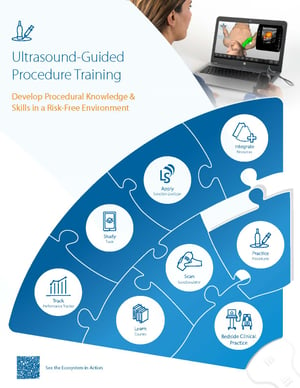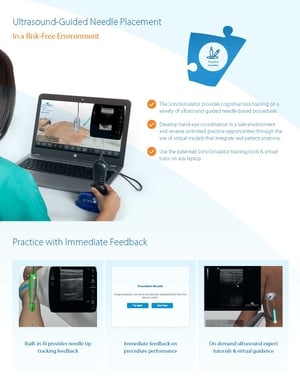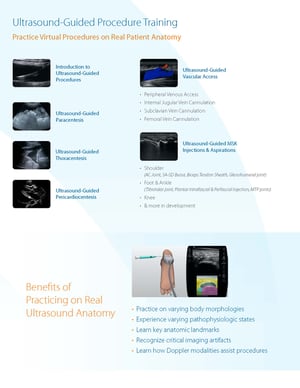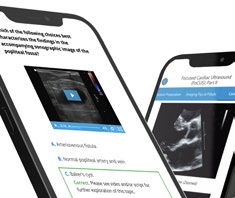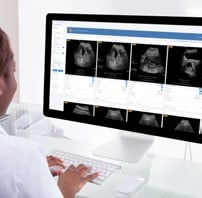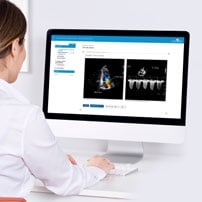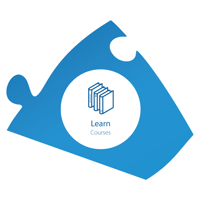Ultrasound-Guided Procedures
Learn to Perform Ultrasound Procedures involving Needle Guidance
Using real-time ultrasound guidance for a multitude of procedures, such as peripheral IV access, is becoming the “standard of care”. However, performing these challenging procedures requires significant ultrasound procedure knowledge and psychomotor skills.
SonoSim provides a safe and convenient setting for learners to practice a variety of ultrasound-guided procedures. This unrestricted access to deliberate practice is an essential element for acquiring the ultrasound procedure knowledge, psychomotor skill, and confidence required for success with ultrasound procedures.

Ultrasound-Guided Procedures: Train in a Risk-Free Environment
Develop ultrasound procedure knowledge and psychomotor skills with SonoSim ultrasound-guided procedure training. SonoSim develops ultrasound procedure knowledge using real patient data sets that vary in body morphology, right versus left-sided approaches, and pathophysiologic states. Learners benefit from SonoSim probe guidance, virtual tutoring, real-time performance feedback, and learning to use advanced Doppler applications during ultrasound procedure survey scans. SonoSim is designed to overcome traditional barriers to ultrasound education, allowing learners to access our resources anytime and anywhere using their PCs.
Optimize Ultrasound-Guided Procedure Success
Improve Your Needle Tip Tracking & Guidance During Ultrasound Procedures
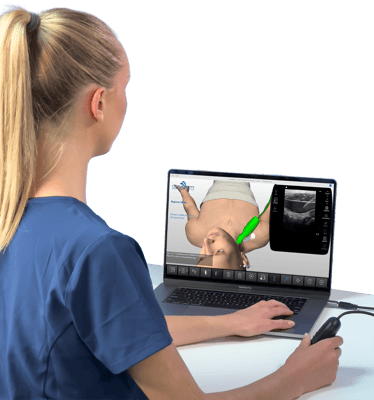
- Train Using Real Patient Anatomy - Learning to recognize sonographic anatomy and key landmarks on real anatomy has significant benefits over alternative approaches (e.g. tissue phantoms, CGI)
- Pathophysiological Variation - Executing ultrasound procedures on target structures that vary (e.g. collapsed internal jugular) matches real-life conditions
- Anatomic Variation - Access to varying body morphologies and right/left side anatomy ensures procedure execution flexibility
- Virtual Tutor & Procedure Guide - Access on-screen tutors and guides to coach you through ultrasound procedures
- Real-time Performance Feedback - Validated expert system-based AI provides real-time procedure feedback on each attempt
- Unlimited Deliberate Practice - Unlimited practice performing ultrasound procedures in a safe, controlled setting
- Breadth of Procedures - A broad & expanding list of ultrasound-guided procedures to choose from
- Flexible, Remote Training - On-demand access to ultrasound-guided procedure training on any laptop, for learners of all levels, from beginner to advanced
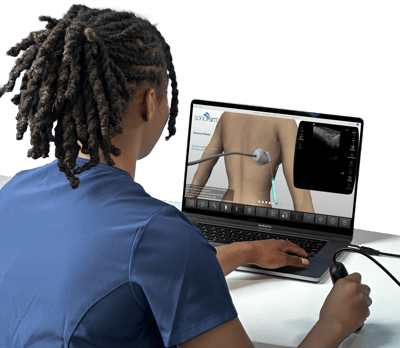
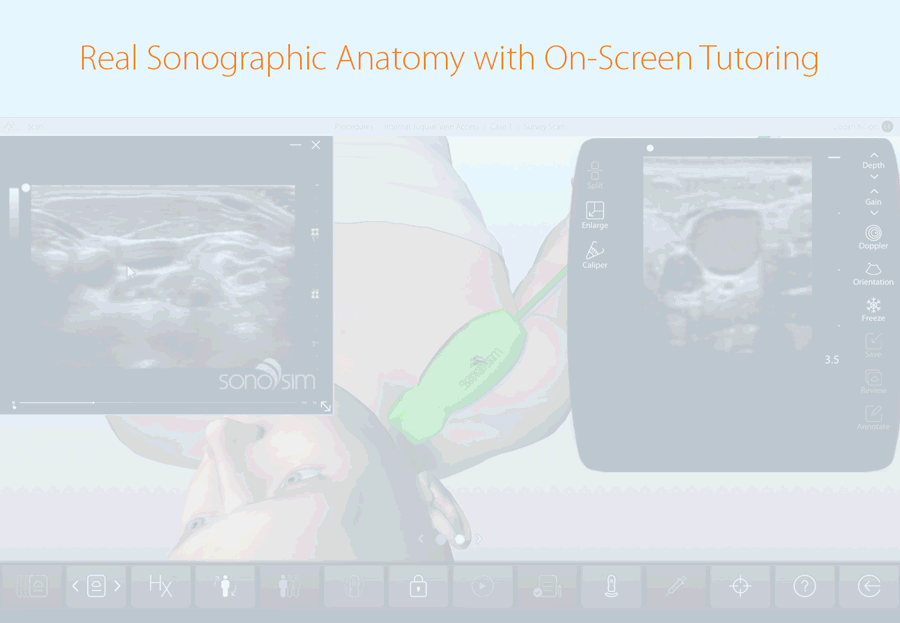
Ultrasound-Guided Cognitive Task Training
Unlimited Practice - Acquire Critical Ultrasound Procedural Skills
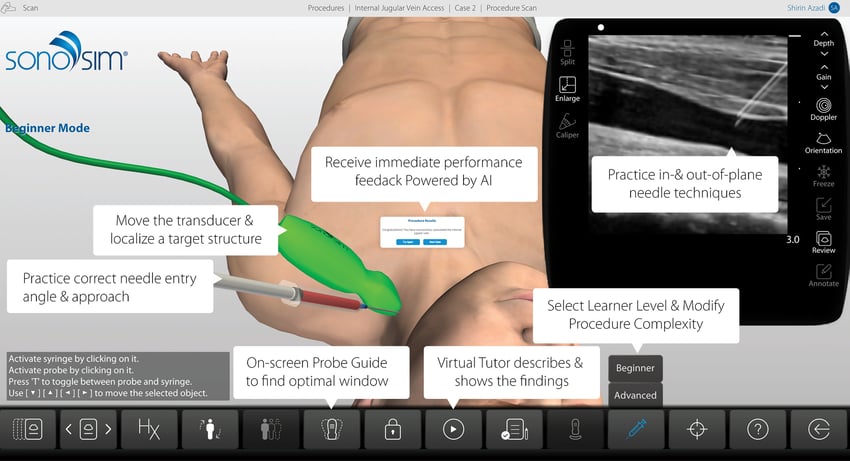
Advanced Ultrasound-Guided Procedure Training
Practice Virtual Ultrasound Procedures on Real Patient Anatomy
Ultrasound-Guided Procedures Introductory Training

Learn the basic principles of performing ultrasound-guided procedures. Develop the requisite hands-on psychomotor skills and cognitive task awareness required to optimally perform ultrasound-guided procedures. Included SkillBox scanning cases provide risk-free cognitive task training opportunities.
Course Highlights |
SonoSimulator Scanning Cases |
|
The course in this module covers topics including:
|
The 10 SkillBox scanning cases in this module include:
|
Peripheral Venous Access Ultrasound-Guided Procedure Training

Learn how to use sonography to guide peripheral venous access in patients. The needle-based peripheral venous access procedure feature provides cognitive task training on ultrasound-guided needle-based procedures. Ultrasound-guided peripheral venous access procedure indications, sonographic techniques and scanning approaches, including imaging tips, pitfalls, and procedure complications are described.
Course Highlights |
SonoSimulator Scanning Cases |
|
The course in this module covers topics including:
|
The 10 real patient scanning cases in this module include and cover:
|
Internal Jugular Vein Cannulation Ultrasound-Guided Procedure Training

Get an in-depth understanding of the basic principles of how to perform ultrasound-guided internal jugular vein cannulation. Develop the requisite hands-on psychomotor skills and cognitive task awareness required to optimally perform ultrasound-guided internal jugular vein cannulation. Ultrasound-guided internal jugular vein cannulation procedure indications, sonographic techniques and scanning approaches, including imaging tips, pitfalls, and procedure complications are also provided.
Course Highlights |
SonoSimulator Scanning Cases |
|
The course in this module covers topics including:
|
The 10 real patient scanning cases in this module include and cover:
|
Ultrasound-Guided Thoracentesis Procedure Training

Learn how to perform an ultrasound-guided thoracentesis. The course explores the use of ultrasound to detect pleural effusions, clinical indications for performing a thoracentesis, procedural complications, and procedural steps for performing ultrasound-guided thoracentesis. Develop the requisite cognitive task awareness and visuospatial skills required to perform ultrasound-guided thoracentesis.
Course Highlights |
SonoSimulator Scanning Cases |
|
The course in this module covers topics including:
|
The 10 real patient scanning cases in this module include and cover:
|
Ultrasound-Guided Paracentesis Procedure Training

Learn how to perform an ultrasound-guided paracentesis. This course explores the use of ultrasound to detect ascites, regional anatomy, clinical indications for performing paracentesis, procedural complications, and procedural steps for performing ultrasound-guided paracentesis. Develop the requisite cognitive task awareness and visuospatial skills required to perform ultrasound-guided paracentesis.
Course Highlights |
SonoSimulator Scanning Cases |
|
The course in this module covers topics including:
|
The 10 real patient cases in this module include and cover:
|
Ultrasound-Guided Pericardiocentesis Procedure Training

Learn the principles of performing an ultrasound-guided pericardiocentesis. Explore the use of ultrasound to detect pericardial effusions, understand clinical indications for performing pericardiocentesis, and how to identify echocardiographic findings suggestive of cardiac tamponade physiology. Learn the steps necessary for performing ultrasound-guided pericardiocentesis. Develop the requisite cognitive task awareness and visuospatial skills required to perform ultrasound-guided pericardiocentesis.
Course Highlights |
SonoSimulator Scanning Cases |
|
The course in this module covers topics including:
|
The 10 real patient scanning cases in this module include and cover:
|
Femoral Line Placement Ultrasound-Guided Procedure Training

Get an in-depth understanding of the basic principles of how to perform ultrasound-guided femoral central line placement. Develop the requisite hands-on psychomotor skills and cognitive task awareness required to optimally perform femoral vein access with the aid of ultrasound.
Course Highlights |
SonoSimulator Scanning Cases |
|
The course in this module covers topics including:
|
The 10 real patient scanning cases in this module include and cover:
|
Subclavian Vein Cannulation Ultrasound-Guided Procedure Training

Get in-depth understanding of the basic principles of how to perform ultrasound-guided subclavian vein cannulation. Develop the requisite hands-on psychomotor skills and cognitive task awareness required to optimally perform ultrasound-guided subclavian vein cannulation. Ultrasound-guided subclavian vein cannulation procedure indications, sonographic techniques and scanning approaches, including imaging tips, pitfalls, and procedure complications are also provided.
Course Highlights |
SonoSimulator Scanning Cases |
|
The course in this module covers topics including:
|
The 10 real patient scanning cases in this module include and cover:
|
Glenohumeral Joint Injection & Aspiration Ultrasound-Guided Procedure Training

Learn the relationship between traditional illustrative anatomy and sonographic anatomy of the glenohumeral joint. Learn how glenohumeral joint injections and glenohumeral joint aspiration is performed, including the location and appearance of critical anatomical components in ultrasound imaging. Sonographic techniques and scanning approaches used in performing ultrasound-guided glenohumeral joint injection and aspiration procedures are covered. Ultrasound-guided glenohumeral joint injection & aspiration procedure indications, sonographic techniques and scanning approaches, including imaging tips, pitfalls, and procedure complications are covered.
Course Highlights |
SonoSimulator Scanning Cases |
|
The course in this module covers topics including:
|
The real patient training case in this module includes and covers:
|
Acromioclavicular Joint Injection & Aspiration Ultrasound-Guided Procedure Training
Learn both the regional and sonographic anatomy of the acromioclavicular joint and how to interpret ultrasound imagery of this joint. Learn sonographic techniques and scanning approaches used in ultrasound-guided acromioclavicular joint injection and aspiration. Learn to evaluate various acromioclavicular joint pathologies with ultrasonography and clinical indications for performing acromioclavicular joint injections and acromioclavicular joint aspiration.
Course Highlights |
SonoSimulator Scanning Cases |
|
The course in this module covers topics including:
|
The one (1) real patient scanning case in this module includes and covers:
|
Subacromial-Subdeltoid Bursa Injection & Aspiration Ultrasound-Guided Procedure Training

Get an in-depth understanding of the basic principles of how to perform ultrasound-guided subacromial-subdeltoid bursal injection and aspiration. The course explores the use of ultrasound to detect bursal fluid and clinical indications for performing the procedure. Subacromial-subdeltoid bursitis, subacromial impingement syndrome, and rotator cuff injuries are discussed. Develop the requisite cognitive task awareness and visuospatial skills required to perform ultrasound-guided subacromial-subdeltoid bursa injection and aspiration. Ultrasound-guided subacromial-subdeltoid bursa injection and aspiration procedure indications, sonographic techniques and scanning approaches, including imaging tips, pitfalls, and procedure complications are described.
Course Highlights |
SonoSimulator Scanning Cases |
|
The course in this module covers topics including:
|
The real patient scanning case in this module includes and covers:
|
Biceps Tendon Sheath Injection Ultrasound-Guided Procedure Training

Learn both the regional and sonographic anatomy and how to interpret ultrasound imagery of the shoulder joint. Learn sonographic techniques and scanning approaches used in ultrasound-guided biceps tendon sheath injection. Learn to evaluate various biceps tendon sheath pathologies with ultrasonography and clinical indications for performing biceps tendon sheath injections.
Course Highlights |
SonoSimulator Scanning Cases |
|
The course in this module covers topics including:
|
The real adult patient training case in this module includes and covers:
|
Tibiotalar Joint Injection & Aspiration Ultrasound-Guided Procedure Training

Get an in-depth understanding of the basic principles of how to perform ultrasound-guided tibiotalar joint injection and/or aspiration. Review relevant anatomy and explore the use of ultrasound to evaluate tibiotalar joint pathologies and clinical indications for performing the procedure. Acute and chronic pathologic conditions that afflict the tibiotalar joint are discussed, including trauma, degenerative arthritis, cartilaginous lesions, inflammatory conditions, and infections. Develop the requisite cognitive task awareness and visuospatial skills required to perform ultrasound-guided tibiotalar joint injection.
Course Highlights |
SonoSimulator Scanning Cases |
|
The course in this module covers topics including:
|
The real patient training case in this module includes and covers:
|
Metatarsophalangeal Joint Injection & Aspiration Ultrasound-Guided Procedure Training

Learn the basic principles of performing ultrasound-guided metatarsophalangeal joint injection and aspiration. Review relevant anatomy and the use of ultrasound to evaluate metatarsophalangeal joint pathologies. Learn the clinical indications for performing the procedure. Review acute and chronic pathologic conditions that afflict the metatarsophalangeal joint, including trauma, degenerative arthritis, inflammatory conditions, infections, and masses. Develop cognitive task awareness and visuospatial skills required to perform ultrasound-guided metatarsophalangeal joint injection.
Course Highlights |
SonoSimulator Scanning Cases |
|
The course in this module covers topics including:
|
The 2 real patient scanning cases in this module include and cover:
|
Plantar Fasciitis Ultrasound-Guided Injection Procedures

Learn the basic principles of performing ultrasound-guided plantar intrafascial & perifascial injections. Review relevant anatomic landmarks and the use of ultrasound to evaluate the plantar fascia. Learn commonly agreed upon indications for performing this procedure. Develop cognitive task awareness and visuospatial skills required to perform ultrasound-guided injections to alleviate plantar fasciitis.
Course Highlights |
SonoSimulator Scanning Cases |
|
The course in this module covers topics including:
|
The 2 real patient scanning cases in this module include and cover:
|
Neonatal & Infant Lumbar Puncture Ultrasound-Guided Procedure Training

Gain an in-depth understanding of the basic principles of performing ultrasound-guided neonatal and infant lumbar punctures. Review relevant anatomic landmarks that are instrumental to performing ultrasound-guided lumbar punctures. Develop cognitive task awareness and visuospatial skills required to perform the procedure to evaluate for sepsis or central nervous system infections. Review the anatomy of the neonatal and infant spine, and commonly agreed-upon clinical indications for performing ultrasound-guided lumbar punctures. Learn optimal transducer selection, patient positioning, imaging approaches, and sonographic techniques for procedure execution. Imaging tips and pitfalls, and potential procedure complications are discussed.
Course Highlights |
SonoSimulator Scanning Cases |
|
The course in this module covers topics including:
|
The 2 real patient scanning cases in this module include and cover:
|
Perfect Your Ultrasound IV Training Skills & More
in a Safe Virtual Environment
SonoSim provides comprehensive cognitive task training for a variety of ultrasound-guided procedures, including ultrasound for IVs. Learners get real-time feedback following each ultrasound procedure attempt provided by SonoSim’s validated expert system-based AI technology. They also have the ability to use a variety of relevant Doppler modalities. This foundation of procedural knowledge and skill can further be refined using real ultrasound machines and phantoms in more formal settings such as a simulation center. Think of SonoSim as providing the critical pre-training that helps learners get the most out of their limited opportunities using tissue phantoms and real ultrasound machines for ultrasound procedure training.
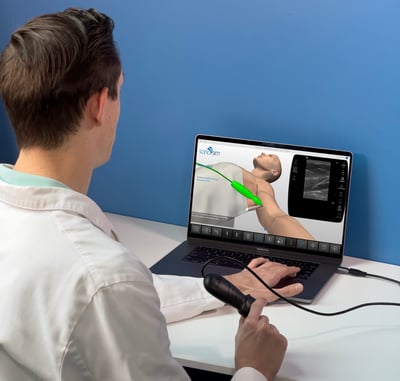
FAQ
What ultrasound-guided procedure training do you offer?
Our library of ultrasound procedures is constantly growing via feedback from our clients. We today provide a variety of needle-based procedures, such as ultrasound IV procedures, as well as complex procedures like renal transplants. See a full list.
Do you offer in-person training?
SonoSim is a self-paced, virtual learning platform for ultrasound, geared to help you incorporate ultrasound learning in the easiest way possible. At this time, we do not offer in-person classes.
What other types of ultrasound training do you offer?
We offer 80+ peer-reviewed ultrasound training topics, ranging across subspecialties and topics. SonoSim provides the industry’s most comprehensive ultrasound training platform, and we are still growing.
Get a full list of all our available topics.
SonoSim Ultrasound-Guided Procedures - Get the Practice Brochure!
Unlimited Ultrasound Procedure Practice in a Virtual, Safe Environment
The SonoSim Ecosystem
Comprehensive Ultrasound Learning & Teaching
Flexible Learning Pathways
A Customizable Ecosystem for Every Program
80+ Ultrasound Courses across a variety of Ultrasound topics and learning levels
Innovative ultrasound simulation environment. Master scanning skills with the SonoSimulator. Accessible anytime, anywhere.
A growing library of Challenge Cases enables learners to continually scan new pathologies & acquire new skills.
Explore the SonoSim Ecosystem
Next Element - Track
The SonoSim ecosystem is made up of 7 separate, yet complementary elements. Learn how each one plays a crucial role in helping you solve the ultrasound competency puzzle.
The SonoSim Wave
An Ultrasound Insights Newsletter
Get the latest trends in ultrasound training, education, & applications delivered to your inbox.



